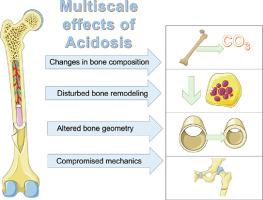Acta Biomaterialia ( IF 9.4 ) Pub Date : 2020-11-23 , DOI: 10.1016/j.actbio.2020.11.033 Anna K Peterson 1 , Mikayla Moody 1 , Iris Nakashima 1 , Ron Abraham 1 , Tannin A Schmidt 1 , David Rowe 2 , Alix Deymier 1

|
Physiologic pH is maintained in a narrow range through multiple systemic buffering systems. Metabolic Acidosis (MA) is an acid-base disorder clinically characterized by a decrease in systemic pH and bicarbonate (HCO3−) levels. Acidosis affects millions annually, resulting in decreased bone mineral density and bone volume and an increased rate of fracture. We developed an adult murine model of diet-induced metabolic acidosis via graded NH4Cl administration that successfully decreased systemic pH over a 14 day period to elucidate the effects of acidosis on the skeletal system. Blood gas analyses measured an increase in blood calcium and sodium levels indicating a skeletal response to 14 days of acidosis. MA also significantly decreased femur ultimate strength, likely due to modifications in bone morphology as determined from decreased microcomputed tomography values of centroid distance and area moment of inertia. These structural changes may be caused by aberrant remodeling based on histological data evidencing altered OCL activity in acidosis. Additionally, we found that acidosis significantly decreased bone CO3 content in a site-specific manner similar to the bone phenotype observed in human MA. We determined that MA decreased bone strength thus increasing fracture risk, which is likely caused by alterations in bone shape and compounded by changes in bone composition. Additionally, we suggest the temporal regulation of cell-mediated remodeling in MA is more complex than current literature suggests. We conclude that our model reliably induces MA and has deleterious effects on skeletal form and function, presenting similarly to the MA bone phenotype in humans.
中文翻译:

酸中毒对成年鼠股骨结构、组成和功能的影响
通过多种全身缓冲系统将生理 pH 值维持在一个狭窄的范围内。代谢性酸中毒 (MA) 是一种酸碱紊乱,临床上以全身 pH 值和碳酸氢盐 (HCO 3 - ) 水平降低为特征。酸中毒每年影响数百万人,导致骨矿物质密度和骨量减少以及骨折率增加。我们通过分级 NH 4开发了饮食诱导的代谢性酸中毒的成年鼠模型在 14 天内成功降低全身 pH 值的 Cl 给药,以阐明酸中毒对骨骼系统的影响。血气分析测量了血钙和钠水平的增加,表明骨骼对酸中毒 14 天的反应。MA 还显着降低了股骨的极限强度,这可能是由于从质心距离和面积惯性矩的微计算机断层扫描值降低所确定的骨形态的改变。这些结构变化可能是由基于组织学数据的异常重塑引起的,这些数据证明了酸中毒中 OCL 活性的改变。此外,我们发现酸中毒显着降低骨 CO 3以类似于在人类 MA 中观察到的骨表型的特定部位的方式含量。我们确定 MA 降低了骨强度,从而增加了骨折风险,这可能是由于骨形状的改变和骨成分的变化造成的。此外,我们认为 MA 中细胞介导的重塑的时间调节比目前的文献表明的更复杂。我们得出结论,我们的模型可靠地诱导 MA 并对骨骼形式和功能产生有害影响,类似于人类的 MA 骨表型。







































 京公网安备 11010802027423号
京公网安备 11010802027423号